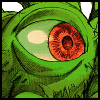Multiplayer in the Zelda Series
Posted on March 16 2012 by Axle D. Wilder
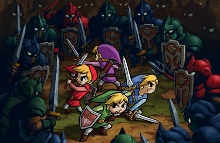 The topic of multiplayer in the Zelda series is a bit of a strange one. Despite being able to occasionally find elements from other genres in certain games in the series, Zelda is first and foremost an adventure game, where your focus is going to be on completing a journey, but also just finding things and enjoying the journey itself. It’s not exactly a genre in which one often finds multiplayer functionality, but on occasion Zelda games do have multiplayer elements, either in the form of some special connectivity, or in actual multiplayer modes with more than one player participating. I’m going to examine the instances of it within the series as well as discuss my thoughts about the topic in general.
The topic of multiplayer in the Zelda series is a bit of a strange one. Despite being able to occasionally find elements from other genres in certain games in the series, Zelda is first and foremost an adventure game, where your focus is going to be on completing a journey, but also just finding things and enjoying the journey itself. It’s not exactly a genre in which one often finds multiplayer functionality, but on occasion Zelda games do have multiplayer elements, either in the form of some special connectivity, or in actual multiplayer modes with more than one player participating. I’m going to examine the instances of it within the series as well as discuss my thoughts about the topic in general.
The most obvious examples of existing multiplayer functions in The Legend of Zelda series are Four Swords and the extra modes in Phantom Hourglass and Spirit Tracks, so these will be the topics I’ll be covering first. There are however some additional things I will cover later in the article.
The most obvious example of actual multiplayer in Zelda is Four Swords. The original Four Swords was released as an extra for the Game Boy Advance re-release of A Link to the Past. This multiplayer “mode” was actually more of a small sub-game of its own, and was essentially a collection of stages in which up to four players would take control of a different colored Link to fight monsters and solve puzzles using teamwork, while they also competed for rupees in order to rank higher than the other players.
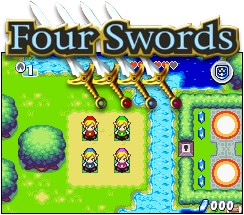 Four Swords basically played like a traditional 2D Zelda game, with a few alterations. Players would go through a level laid out like a dungeon, finding some way to reach the stage exit either by navigating through the stage, collecting keys, or both. An assortment of traditional Zelda challenges bar the players’ path, but many of them are now designed to require teamwork. This is especially true of the boss fights. The levels themselves have somewhat randomized layouts, allowing for variety.
Four Swords basically played like a traditional 2D Zelda game, with a few alterations. Players would go through a level laid out like a dungeon, finding some way to reach the stage exit either by navigating through the stage, collecting keys, or both. An assortment of traditional Zelda challenges bar the players’ path, but many of them are now designed to require teamwork. This is especially true of the boss fights. The levels themselves have somewhat randomized layouts, allowing for variety.
Four Swords wasn’t really that well received when it originally came out, probably due to needing a system for each player, but I don’t believe it was actually because people despised the idea of a multiplayer Zelda game. Having recently played the Anniversary Edition of the game myself, I actually had a lot of fun with it, and having more people to play it with would have made it even better.
The idea of taking familiar gameplay and attaching a multiplayer element to it is a good one, and evidently Nintendo thinks so too considering they later released Four Swords Adventures and then applied the same concept to a number of their other series with Metroid Prime Hunters, New Super Mario Bros. Wii, Kirby’s Return to Dream Land, and Donkey Kong Country Returns. Too many games decide to add multiplayer modes that are very different from the regular game, but this formula promises that you’re still playing the game, just with more people. With the Zelda series in particular, which is known for its unique brand of adventure gameplay, I find that this is especially crucial, and I think this could arguably be the best type of multiplayer for the series.
As for the idea of co-op gameplay in general, outside of the Four Swords games… it’s actually pretty common in gaming these days. A lot of games introduce co-op elements, because multiplayer has evidently become a fairly significant trend in gaming. This is especially true of first person shooters, but you even see it in games like Demon Souls, with its various ways of having other players join your game, or Super Mario Galaxy, where a second player can manipulate the environment to help you. Recently people just seem to really like the idea of having the option to play with someone else no matter what game they’re playing, so it’s definitely going to come up when talking about how Zelda is similar — or different — from the rest of modern gaming.
I don’t think Zelda games should stress to offer the co-op experience though. As I said at the beginning of this article, Zelda is primarily a single-player adventure game, and throughout the various major entries in the series, this pretty much doesn’t change. Allowing a second player to jump into a single player experience does alter that experience, and I don’t think it’s something Zelda should generally tamper with.
 The Wind Waker did offer a form of co-op like this with the Tingler Tuner, and with a connected Game Boy Advance you could use it to aid the main player by detecting secrets and spending their rupees to activate a variety of special powers, including making the player levitate or dropping bombs on enemies. This is an example of Nintendo adding co-op to their existing single-player formula, and is actually the very first instance of traditional multiplayer appearing in a Zelda game.
The Wind Waker did offer a form of co-op like this with the Tingler Tuner, and with a connected Game Boy Advance you could use it to aid the main player by detecting secrets and spending their rupees to activate a variety of special powers, including making the player levitate or dropping bombs on enemies. This is an example of Nintendo adding co-op to their existing single-player formula, and is actually the very first instance of traditional multiplayer appearing in a Zelda game.
I have not actually played the game with the Tingle Tuner, so I don’t have any firsthand experience, though I do know how it works and have seen gameplay of it. I don’t think it looks like something that really matters, something that Nintendo should spend much time on, and I certainly won’t be making serious use of it as I’ll prefer to overcome challenges on my own… But I can’t honestly say it’s hurting the game. It’s a harmless and inoffensive add-on that players can use if they want things to be easier or if they want to experience the game with someone else.
I think I would object to a main entry in the series where another player could participate in full, but having odd add-ons like this doesn’t bother me. That’s probably a good thing, since the new Wii U’s controller makes a mode like this easier than ever. Particularly if Nintendo uses Skyward Sword’s Wii Motion Plus controls again like they’ve said they will, that leaves the actual Wii U controller completely unused, so it’s very possible we will see something very similar to the Tingle Tuner return in the next game on the console. If this happens, I wouldn’t care for it, but I wouldn’t hate it either.
Then there’s Phantom Hourglass’ and Spirit Tracks’ multiplayer components. Both of these games had special multiplayer modes completely separate from the main adventure. These modes offer a scenario very different from the main quest, though they use essentially the same controls.
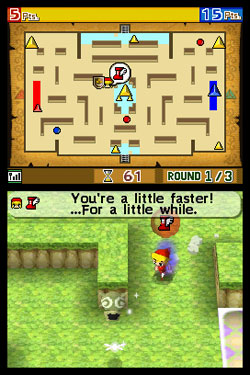 In Phantom Hourglass it’s essentially an elaborate variation on capture the flag, in which two players take turns playing as Link, during which time they must collect Force Gems of various point values and hold them in safe zones of their color to score, and are even able to steal them from the other player. Meanwhile the other player controls three Phantoms and tries to stop them. It’s a simple premise but strategies and maneuvers can get fairly complicated as players compete across a variety of maps in a combination of strategy, stealth, and action. On the other hand, Spirit Tracks’ multiplayer mode is a simple competition in which several Links run around the map gathering up Force Gems, and using various indirect means to steal Force Gems away from the other players while avoiding hazards and Phantoms. A simple battle mode in which the players must defeat each other can also be found in Four Swords Adventures, separate from the main co-op game.
In Phantom Hourglass it’s essentially an elaborate variation on capture the flag, in which two players take turns playing as Link, during which time they must collect Force Gems of various point values and hold them in safe zones of their color to score, and are even able to steal them from the other player. Meanwhile the other player controls three Phantoms and tries to stop them. It’s a simple premise but strategies and maneuvers can get fairly complicated as players compete across a variety of maps in a combination of strategy, stealth, and action. On the other hand, Spirit Tracks’ multiplayer mode is a simple competition in which several Links run around the map gathering up Force Gems, and using various indirect means to steal Force Gems away from the other players while avoiding hazards and Phantoms. A simple battle mode in which the players must defeat each other can also be found in Four Swords Adventures, separate from the main co-op game.
These modes are fun to play to be sure, but they’re simplistic. Since they aren’t a part of the main game, they don’t do any damage to the single-player experience and are harmless. However, like many multiplayer modes built onto otherwise solo games, they definitely are not full experiences of their own. These are distractions thrown into the game for the sake of multiplayer, and are not generally something you’re going to be spending a lot of time on.
As I said, it’s harmless adding modes like these because they don’t hurt the game, but if they’re going to be adding them, it would be nice to see them go a little further to make them into worthwhile experiences on their own. Perhaps instead, Nintendo could spend time fleshing out their minigame concepts in spinoffs? I’ve always maintained that even if I insist a series keep its core elements intact, spinoffs are free to experiment wildly, and I think that applies even with multiplayer. Four Swords, after all, was a multiplayer spinoff.
Honestly, I think a new Four Swords game or something resembling it might actually have some real chances of happening on the Wii U, especially with the design of the console and its controller. This is made even more likely by Nintendo’s recent attention on the old Four Swords, adding more content to it and re-releasing it for Zelda’s 25th Anniversary, as well as talking about it a lot lately. I think that Nintendo may begin to give Zelda and its multiplayer as much attention as it has done with Mario and its other properties. I think Nintendo is trying to compete with the industry’s current preference for multiplayer, just in their own unique way.
The last thing I’d like to bring up is connectivity. This is something Nintendo is no stranger to, since they’re famous for it with the Pokemon series, in which they have many games with unique content that can link up to transfer your monsters to new games, or just to collect monsters from other players. They also made a big deal out of GameCube/Game Boy Advance connectivity. The biggest point, of course, is how much they did this in Oracle of Ages and Seasons with linked games, sharing secrets and passwords between games, and trading collectible ring accessories. This feature was also in Phantom Hourglass and Spirit Tracks, as a part of treasure and vehicle parts. In Phantom Hourglass and Spirit Tracks, you collect treasures for purposes that differ between the two games and can trade them with other players. In Phantom Hourglass, which treasures are valuable and rare and which ones are common and worthless are completely randomized when you start the game. Players can trade their treasures with other players, and ideally this would involve you giving your friend a treasure that you can find easily but that is very rare for them. Phantom Hourglass also had the player collect ship parts, which are also acquired randomly. Collecting all of them is difficult without trading with friends.
 As you probably know, a similar treasure system reappeared in Skyward Sword, in which you used the treasures to upgrade equipment or just sold them for money. This game did not use any kind of connectivity feature, but I still think the prospects of having functionality like this in Zelda games is interesting.
As you probably know, a similar treasure system reappeared in Skyward Sword, in which you used the treasures to upgrade equipment or just sold them for money. This game did not use any kind of connectivity feature, but I still think the prospects of having functionality like this in Zelda games is interesting.
I’d actually argue that implementing a well designed and especially elaborate trading system into a future Zelda release along with a connectivity feature, either locally with handhelds or even over wifi, would be a very compelling and would be more distinctly Zelda than having full multiplayer. Perhaps they could have an even larger variety of treasures or collectibles, with a variety of ways to acquire them through combat and exploration, then limit which ones you can find either randomly or through player choice, allowing individual playthroughs to be more unique while also allowing players to still get everything by trading with others. Optional upgrades would be handled through these treasures — and perhaps other items too, such as rings, medals, or similar accessories — allowing your extended inventory to need even more care and strategy. It could be interesting, and I’m sure as newer Zelda games implement new features I haven’t envisioned, there will be other opportunities to implement interesting connectivity features, though whether Nintendo would choose to do so or not is unclear.
At the very least, connectivity and trading are within the spirit of the Zelda games; as early as the original Legend of Zelda and as recently as the latest game, players often swap tips and discoveries they’ve made within the games and share secrets. Swapping actual items and treasure is the next evolution of that concept.
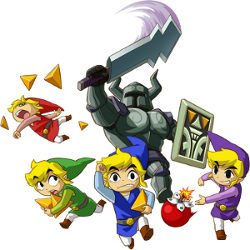
Interacting with other players is something people have enjoyed for a long time in gaming. While some genres are more immediately compatible with multiplayer, it can be made to work almost anywhere if you’re creative and careful enough. I think it definitely has been shown to work in Zelda, and it’s interesting examining all the different ways it’s been done and thinking about how they could do things in the future. What could they do to expand existing Zelda multiplayer ideas? What entirely new ideas could they do? The idea of a massively multiplayer online Zelda game has floated around for a while. Who wouldn’t want to explore a massive Hyrule and all its towns and dungeons with their friends?
I’ll always maintain that Zelda is a single player series, for the most part, and that Nintendo should keep its main focus on the solo adventure. But finding unintrusive ways of involving other players is a good thing. I would be happy to see neat little multiplayer functions tacked onto otherwise single-player games, as long as they don’t take too much time away from the main game to do it. If they are able, it might be nice to see these fleshed out more or made into their own games. Fully multiplayer Zelda games are fun, and perfectly excusable. It would also, as I’ve said, be fascinating to see what Nintendo could do with Zelda and various connectivity ideas.
Here’s hoping that Nintendo hasn’t forgotten about multiplayer, whether it’s co-op, competitive, or just connectivity. This is something that’s fun in any game, and can be amazing in Zelda if done right.
~~~Recent Content Updates~~~
- Skyward Sword Bosses
- Skyward Sword Bottles
- Skyward Sword Bugs
- Skyward Sword Characters
- Skyward Sword Enemies
- Skyward Sword Equipment
- Skyward Sword Goddess Cubes
- Skyward Sword Gratitude Crystals
- Skyward Sword Items
- Skyward Sword Official Artwork
- Skyward Sword Pieces of Heart
- Skyward Sword Screenshots
- Skyward Sword Story
- Skyward Sword Treasure
- Skyward Sword Upgrades
- Skyward Sword Video Walkthrough
- Skyward Sword Walkthrough
- The Minish Cap Walkthrough
~~~Recent Wiki Articles~~~



